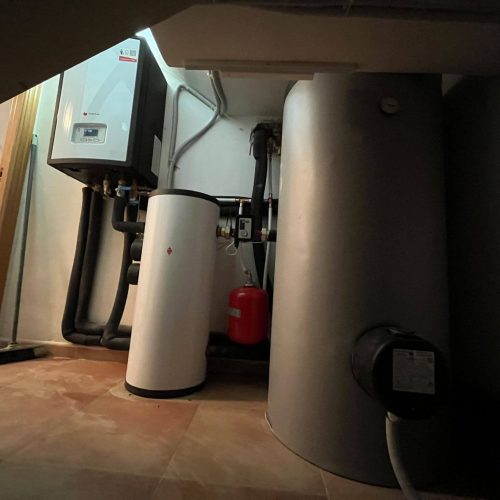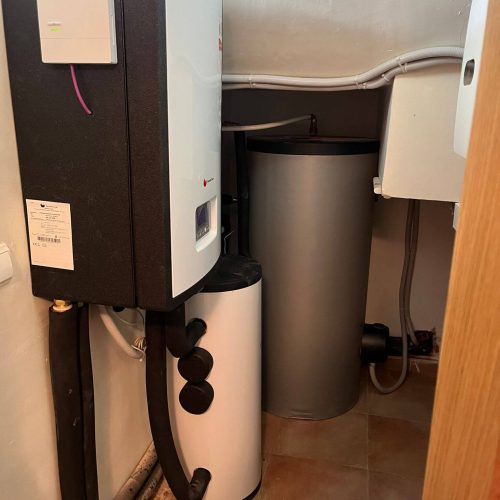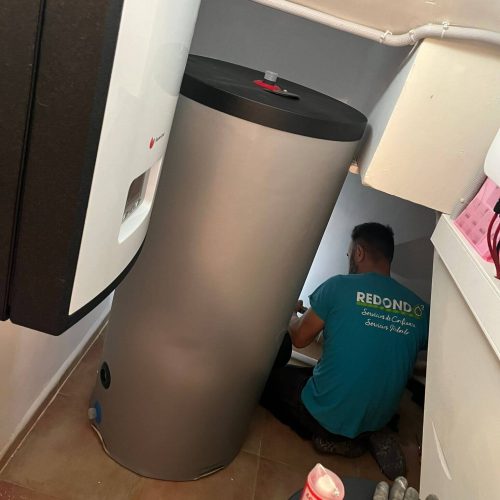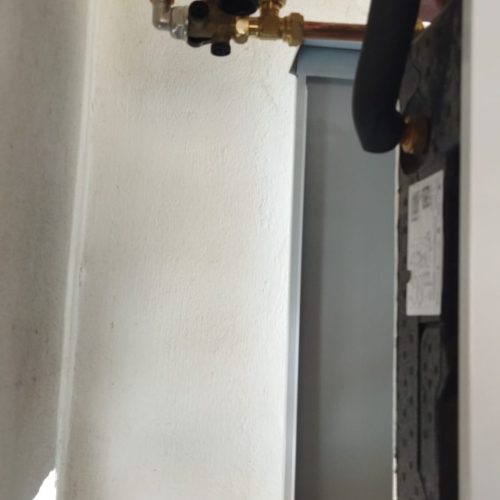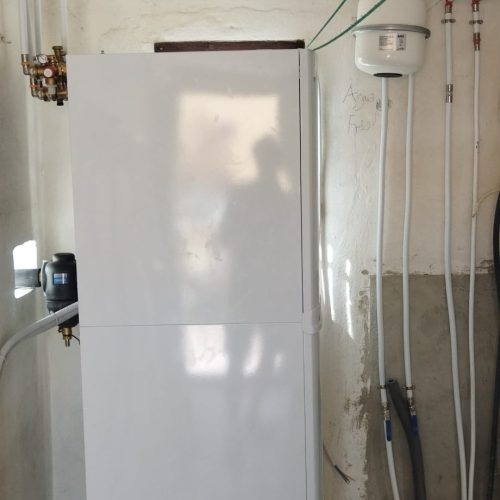TABLE OF CONTENTS
- Grants for the installation of aerothermal in Valencia
- What is the cost of installing aerothermal at home?
- Elements to consider when calculating the cost of an aerothermal installation
- How long does it take to recover the investment of the aerothermal installation?
- Calculation of the heat pump capacity
- How long does it take for a room to heat up with Aerothermal energy?
- What maintenance does my aerothermal system require?
- Key maintenance points
TABLE OF CONTENTS
- How much does it cost to install solar panels in Valencia?
- Subsidies for the installation of solar panels in Valencia
- Recoup your investment thanks to solar self-consumption subsidies
- Installation of solar panels in Valencia
- Investor for solar panel installation in Valencia
- Batteries for photovoltaic installations
- What are the advantages of installing solar panels in Valencia?
- What maintenance do solar panels require?
- Why do you need a professional installer?
- Sell your surplus


Aerothermal in Valencia
Are you seeking an efficient heating solution that is both environmentally friendly and energy-saving in Valencia? Aerothermal is the answer! Aerothermal is a heating and cooling system that uses outside air as a renewable energy source.
MASRED offers installation and maintenance services for Aerothermal in Valencia. Our team of highly trained professionals has extensive experience in the sector.
Grants for the installation of aerothermal in Valencia
Thanks to the aid programs in residential housing and social housing within the Government’s Recovery, Transformation, and Resilience Plan, all autonomous communities enable us to apply various subsidies, creating incentives to use renewable energy sources for self-consumption and storage, as well as for the installation of thermal systems.
This can be very beneficial for you, as these grants are direct and result in significant savings when installing aerothermal systems with MASRED Engineering.
These grants allow aerothermal to be subsidized with up to €3,000 per unit.
To determine the subsidy amount, please note that it varies depending on the type of action and the beneficiary. For:
- Private households: €500/kW up to a maximum of €3,000.
- Publicly owned housing: €650/kW up to a maximum of €3,900.
It should be noted that this subsidy is incompatible with other aid or subsidies intended for the same purpose; however, the Next Generation aid is compatible with IRPF and Corporate Tax deductions.
What is Royal Decree 477/2021?
This program aims to provide subsidies for renewable thermal energy installations, including aerothermal, in both the residential and public sectors. The different entities that can benefit from the aid are:
- Individuals.
- Self-employed workers who wish to install it in their private homes.
- Local entities and the public sector are experiencing a lack of economic activity.
- Renewable energy communities, homeowners’ associations, and citizen energy communities (without economic activity).
- City councils, provincial councils, island councils, and any public bodies and public law entities.
IRPF Deduction for aerothermal in Valencia
In 2021, several measures approved by the Government came into force to encourage building rehabilitation activity. Among all of them, the IRPF deduction for the installation of aerothermal and renewable energy sources in homes was included.
The installation of aerothermal systems in homes can achieve an IRPF deduction increase of up to 40%.
IRPF Deductions, depending on the installation
When energy improvements are made to a home or rental property, the IRPF deduction can be increased by up to 40%. For this, certification is required, which proves that at least 30% of non-renewable primary energy consumption has been reduced.
It can also be applied if the works have resulted in an improvement in the home’s energy rating, enabling it to achieve an “A” or “B” rating on the same scale.
It can be accessed until December 31, 2022. In the case of a rental property, it must be rented before December 31, 2023.
And the maximum base on which the deduction is applied in this modality amounts to €7,500 annually.
The deduction will be applied in the tax year in which the energy efficiency certificate is issued, following the completion of the works.
What is the cost of installing aerothermal at home?
To carry out the installation of an aerothermal system in Valencia, the time required for two people to complete the work corresponding to installing a system with an aerothermal heat pump in a medium-sized single-family house should not exceed 3–4 days.
It is essential to consider this time when evaluating the cost of hiring an aerothermal installer.
This will result in an approximate cost of between €1,500 and €2,000.
As we have observed, for a standard single-family house of 180 m² using an aerothermal heat pump system, the price is around €11,000.
If underfloor heating is added, the price will be closer to €19,000.
Based on our experience installing aerothermal systems in Valencia, the price per square meter is approximately €60 if underfloor heating is not included, or € 106 per square meter if underfloor heating is installed.
It should be noted that these are approximate values, based on past client installations, and that the prices mentioned are indicative, with budgets varying depending on the type of installation.
Contact us without obligation!
Controller: INGENIERÍA MASRED, S.L.
Purpose: Management of the contact form.
Legitimation: Express consent given by checking "I have read and accept the privacy policy."
Recipients: Assignments and/or transfers to third-party companies and/or organizations as indicated in the additional information.
Rights: Access, rectification, opposition, limitation, as well as other rights duly included in the additional information.
+ Information: You can consult additional information in this regard through the following link: Privacy Policy
Elements to consider when calculating the cost of an aerothermal installation
Aerothermal heat pumps provide high energy performance. Since they have a performance coefficient of 4 to 5, this means that for each kWh of electricity consumed from the grid, the aerothermal equipment can produce between 4 and 5 kWh of extra clean energy.
These systems operate, consuming approximately 25% of the electricity. Their technology is designed to operate with high efficiency, making these aerothermal heat pumps the ideal option for a hybrid system with other energy sources, such as solar panels or solar collectors, which enhance efficiency and generate greater savings.
If the chosen option is an aerothermal and photovoltaic installation, the economic savings on energy bills are highly guaranteed, as up to 75% of the energy consumed in your home will come from clean or renewable sources, and the remaining 25% will be for electricity consumption.
MASRED Engineering’s personalized aerothermal projects are tailor-made, taking into account all factors, not only the square meters of the home, but also other factors such as outside temperature at different times of the year, as well as the zone where the system will be implemented.
Aerothermal installations take advantage of the energy present in the air to provide both heating and DHW as well as cooling, and even pool heating. It is, therefore, a renewable system, as the resource is continually regenerated. Thus, it is not reduced or exhausted.
A heat pump installation requires a series of fundamental components standard to all installations. Costs can be very diverse; however, a general approximation is provided:
Two classifications are presented for the heat pump, depending on the number of units the equipment integrates:
Monobloc heat pump price
These systems include a single-unit cooling circuit installed outdoors. They are characterized by being larger in size and having a lower installation cost, as they eliminate the need for a refrigerant connection between the indoor and outdoor units.
The investment for a 10 kW monobloc aerothermal system is around €8,000.
Bibloc heat pump price
Bibloc heat pumps consist of two units: the outdoor unit and the indoor unit. The outdoor unit captures energy from the air. The indoor unit is responsible for regulating the equipment, which includes the heat exchanger and the circulation pump.
The investment for a 10 kW bibloc heat pump without an integrated storage tank is approximately €7,500.
If an integrated storage tank is desired, the price increases to approximately €9,500.
DHW (domestic hot water) tank
It is essential to note that in installations with aerothermal heat pumps, a DHW tank must be acquired to provide hot water.
In many cases, the indoor unit of the heat pump already includes it. In other cases, an external storage tank must be installed to generate domestic hot water. In a single-family home, storage volumes are estimated to be between 150 and 400 liters. Therefore, the price of a DHW tank in this range would be between €1,500 and €1,700.
If stainless steel tanks or instant production DHW tanks are used, the investment cost will increase by up to 80%.
Buffer tank
Is it really necessary to install a buffer tank?
It is recommended to install a buffer tank for the systems mentioned above with heat pumps. Since it provides numerous advantages for operation, energy savings, and its cost is not high.
However, in cases where the heat pump does not have inverter technology, using a buffer tank is totally necessary for the optimal operation of the system in general.
The best option is to invest in a buffer tank with a volume of 10–15 liters for each kilowatt of heat pump power. Without an inverter compressor, this ratio would increase.
The investment in buffer tanks is relatively low, at around € 2.50 per liter, as they are manufactured from carbon steel.
According to calculations, the buffer tank for a 10 kW installation would have a cost of around €350–500.
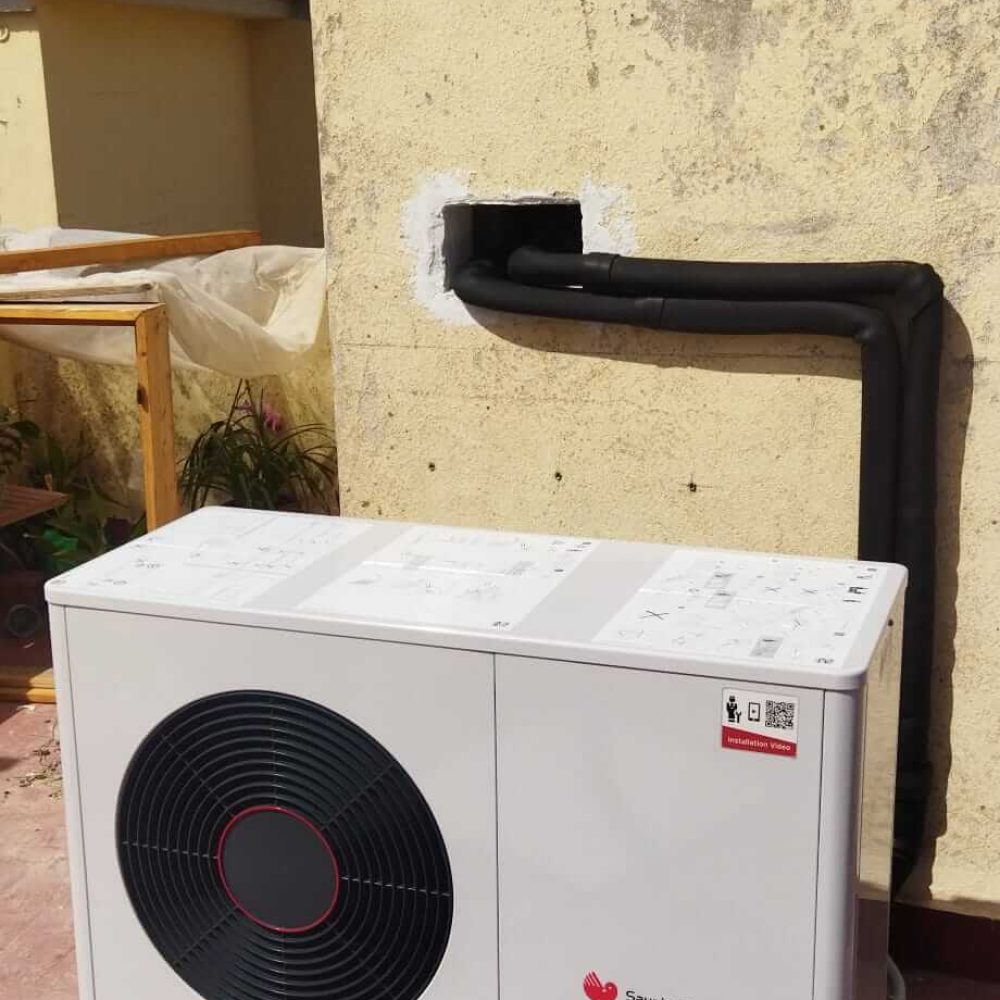
How long does it take to recover the investment of the aerothermal installation?
It is estimated that the payback period for this investment is between 3 and 4 years. Thanks to the high energy savings achieved with an air-to-water heat pump system.
Are you curious to know the price of an aerothermal installation for your home in Valencia?
At MASRED Engineering S.L., we can provide you with a quote, along with a free, no-obligation energy study. This study will outline the cost of the aerothermal installation, estimated consumption, and the savings achieved compared to other traditional systems.
Calculation of the heat pump capacity
- For heating demand: 180m² x 63 W/m² = 11.34 kW
- Power required for cooling: 180m² x 32 W/m² = 5.76 kW
- If we include DHW demand: 5 people x 0.2 kW/person = 1 kW
It is worth noting that heating and cooling demands will never coincide. Therefore, the highest consumption record is taken. According to the data shown above, the heating requirement is 11.34 kW. To this, the power required for DHW, 1 kW, will be added, concluding that a heat pump capable of delivering 12.34 kW is needed when weather conditions approach 2°C, which is the minimum average temperature in the area.
How long does it take for a room to heat up with Aerothermal energy?
Let’s say each room has a circuit. If the distance from the mixer to the room is considerable and it is also a large room, it will take a significant amount of time to heat up (between 6 and 12 hours). On the other hand, if the room is close to the mixer, it can heat up in less than 2 hours.
Who regulates everything related to aerothermal energy?
RITE (Regulation of Thermal Installations in Buildings) is what regulates in Spain everything related to air conditioning and the production of domestic hot water since 2007.
What maintenance does my aerothermal system require?
Aerothermal maintenance by law
The regulation of thermal installations in buildings states the following about the maintenance of installations and their frequency:
- Aerothermal systems do not run on gas (fuel) and will not exceed 70 kW in domestic environments.
- If your aerothermal system is used for heating and air conditioning, there are two options:
- Less than 12 kW (most common): maintenance every 4 years.
- More than 12 kW: maintenance every 2 years.
- If you have installed the system only for heating, for example, with underfloor heating, apparently you do not fall into either of these cases, and you would fall under the following regulation:
(For aerothermal installations whose useful nominal power is less than or equal to 70 kW, when there is no User and Maintenance Manual, maintenance will be carried out according to the professional criteria of the maintenance company.)
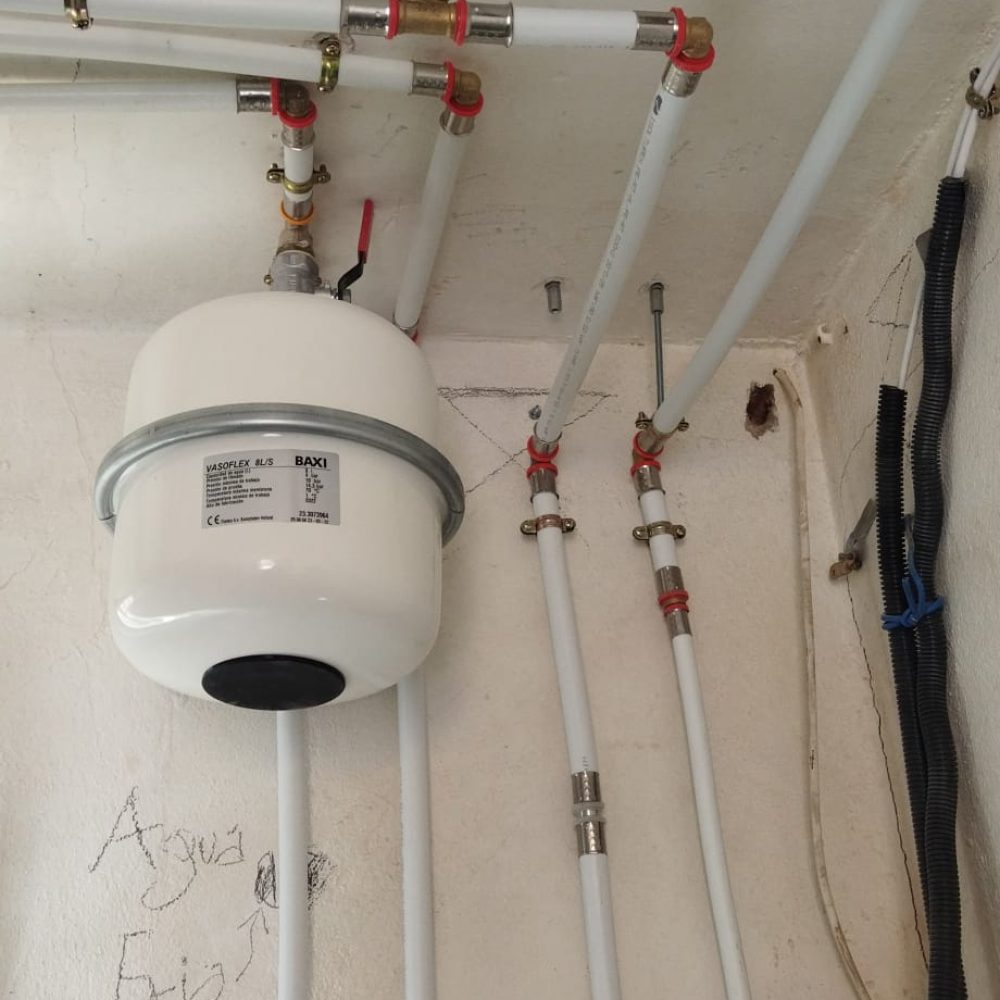
Key maintenance points
Let’s take a look at the key points of an aerothermal installation regarding maintenance:
Water circuit pressure
For example, in a boiler and radiator installation, the water circuit needs to maintain a constant pressure. For this reason, it is advisable to check the pressure and refill the system with water if required. In heating and cooling installations, this point must be verified due to the stress the circuit undergoes when switching between hot and cold.
The system features a high-energy efficiency solution, resulting in considerable savings. Therefore, it is vital to understand the maintenance requirements of aerothermal systems to ensure optimum performance.
At Ingeniería MASRED, we outline the key points of correct aerothermal system maintenance, including the frequency of maintenance and the indicative cost of this service.
The RITE (Regulation on Thermal Installations in Buildings) has regulated everything related to air conditioning and the production of domestic hot water in Spain since 2007.
How often should aerothermal maintenance be carried out?
The inspection of aerothermal equipment with a heat output of less than 70 kW is required by law every two years. However, we recommend conducting preventive maintenance on an annual basis to detect any faults promptly and avoid unexpected expenses.
Tips for aerothermal maintenance
We recommend that our specialised technical service carry out this work.
The steps to follow for aerothermal system maintenance are as follows:
- Cleaning the filters to ensure a healthy environment.
- Sanitising the outdoor unit coil to guarantee correct airflow.
- Removing dirt from the fan and the indoor coil.
- Disinfecting the system with bactericidal products.
- Checking the hydraulic circuits of the heat pump through a series of simple actions to ensure operability (a certified company must do this).
- Adjusting the refrigerant charge of the unit and ensuring there are no leaks.
- Inspecting belts and lubricating motors.
- Controlling the domestic hot water (DHW) tanks, including:
- Monitoring humidity levels.
- Ensuring there is no corrosion or rust.
- Checking connections and possible leaks.
- Verifying the condition of valves, air vents, and wiring.
- Ensuring thermostat sensors work properly.
By following these maintenance recommendations for your aerothermal system, you will maintain its efficiency level and reduce potential issues such as:
- Reduced airflow.
- System shutdown.
- Improper heating or cooling performance.
How often should I carry out maintenance on the aerothermal system?
Initially, it is challenging to determine, as it will depend on how frequently you use your equipment. Let’s take an example:
It is not the same to check an aerothermal system that you use several days a year as it would be to have it in a house in a snowy area, very cold, or in the high mountains, where it will be running 24 hours a day.
Therefore, it is essential to monitor the specific maintenance needs of your aerothermal equipment and promptly identify the signs that indicate it requires servicing.
Some warnings you may notice in your aerothermal system are:
- Operating or start-up problems.
- Reduced air output.
- Strange noises.
- Does not heat or cool as it should.
We are qualified professionals with years of experience in the sector. Our clients trust the excellent service of Ingeniería MASRED.
- Please let us know your needs by completing the form or calling us directly.
- Our engineers will prepare the quote and manage it on your behalf in a personalized manner.
- Our technicians will visit your home to carry out the aerothermal installation or address any questions you may have.



